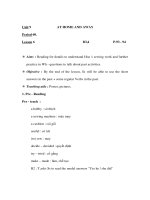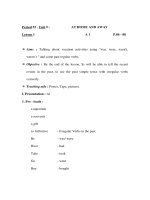Lesson 07 Project Cost and Budget Management
Bạn đang xem bản rút gọn của tài liệu. Xem và tải ngay bản đầy đủ của tài liệu tại đây (435.23 KB, 28 trang )
Lesson 7:
Project Cost and budget
Management
2
Learning Objectives
Understand the importance of project cost management.
Explain basic project cost management principles, concepts, and
terms.
Discuss different types of cost estimates and methods for
preparing them.
3
Learning Objectives
Understand the processes involved in cost budgeting and
preparing a cost estimate and budget for an information
technology project.
Understand the benefits of earned value management and project
portfolio management to assist in cost control.
Describe how project management software can assist in project
cost management.
4
What is Cost and Project Cost
Management?
Cost is a resource sacrificed or foregone to achieve a specific
objective, or something given up in exchange.
Costs are usually measured in monetary units, such as dollars.
Project cost management includes the processes required to
ensure that the project is completed within an approved budget.
5
Project Cost Management Processes
Cost estimating: Developing an approximation or estimate of
the costs of the resources needed to complete a project.
Cost budgeting: Allocating the overall cost estimate to
individual work items to establish a baseline for measuring
performance.
Cost control: Controlling changes to the project budget.
6
Basic Principles of Cost Management
Most members of an executive board have a better understanding
and are more interested in financial terms.
Profits are revenues minus expenses.
Life cycle costing considers the total cost of ownership,
or development plus support costs, for a project.
Cash flow analysis determines the estimated annual
costs and benefits for a project and the resulting annual
cash flow.
7
Table 7-1. Cost of Software Defects
It is important to spend money up-front on IT projects
to avoid spending a lot more later.
8
Basic Principles of Cost Management
Tangible costs or benefits are those costs or benefits that an
organization can easily measure in dollars.
Intangible costs or benefits are costs or benefits that are
difficult to measure in monetary terms.
Direct costs are costs that can be directly related to producing
the products and services of the project.
Indirect costs are costs that are not directly related to the
products or services of the project, but are indirectly related to
performing the project.
Sunk cost is money that has been spent in the past; when
deciding what projects to invest in or continue, you should not
include sunk costs.
9
Basic Principles of Cost Management
Learning curve theory states that when many items are
produced repetitively, the unit cost of those items decreases
in a regular pattern as more units are produced.
Reserves are dollars included in a cost estimate to mitigate
cost risk by allowing for future situations that are difficult
to predict.
Contingency reserves allow for future situations that may be
partially planned for (sometimes called known unknowns)
and are included in the project cost baseline.
Management reserves allow for future situations that are
unpredictable (sometimes called unknown unknowns).
10
Cost Estimating
Project managers must take cost estimates seriously if they want
to complete projects within budget constraints.
It’s important to know the types of cost estimates, how to
prepare cost estimates, and typical problems associated with cost
estimates.
11
Table 7-2. Types of Cost Estimates
12
Cost Management Plan
A cost management plan is a document that describes how the
organization will manage cost variances on the project.
A large percentage of total project costs are often labor costs, so
project managers must develop and track estimates for labor.
13
Table 7-3. Maximum Departmental
Headcounts by Year
A large percentage of the costs of many IT projects are
human resource costs.
14
Cost Estimation Tools and Techniques
Basic tools and techniques for cost estimates:
Analogous or top-down estimates: Use the actual cost of a
previous, similar project as the basis for estimating the cost
of the current project.
Bottom-up estimates: Involve estimating individual work
items or activities and summing them to get a project total.
Parametric modeling: Uses project characteristics
(parameters) in a mathematical model to estimate project
costs.
Computerized tools: Tools, such as spreadsheets and project
management software, that can make working with different
cost estimates and cost estimation tools easier.
15
Cost Budgeting
Cost budgeting involves allocating the project cost estimate to
individual work items over time.
The WBS is a required input for the cost budgeting process
because it defines the work items.
Important goal is to produce a cost baseline:
A time-phased budget that project managers use to
measure and monitor cost performance.
16
Cost Control
Project cost control includes:
Monitoring cost performance.
Ensuring that only appropriate project changes are included in
a revised cost baseline.
Informing project stakeholders of authorized changes to the
project that will affect costs.
Many organizations around the globe have problems with cost control.
17
Earned Value Management (EVM)
EVM is a project performance measurement technique that
integrates scope, time, and cost data.
Given a baseline (original plan plus approved changes), you can
determine how well the project is meeting its goals.
You must enter actual information periodically to use EVM.
More and more organizations around the world are using EVM
to help control project costs.
18
Earned Value Management Terms
The planned value (PV), formerly called the budgeted cost of work
scheduled (BCWS), also called the budget, is that portion of the
approved total cost estimate planned to be spent on an activity
during a given period.
Actual cost (AC), formerly called actual cost of work performed
(ACWP), is the total of direct and indirect costs incurred in
accomplishing work on an activity during a given period.
The earned value (EV), formerly called the budgeted cost of work
performed (BCWP), is an estimate of the value of the physical work
actually completed.
EV is based on the original planned costs for the project or activity
and the rate at which the team is completing work on the project or
activity to date.
19
Rate of Performance
Rate of performance (RP) is the ratio of actual work
completed to the percentage of work planned to have been
completed at any given time during the life of the project or
activity.
Brenda Taylor, Senior Project Manager in South Africa,
suggests using this approach for estimating earned value.
For example, suppose the server installation was halfway
completed by the end of week 1. The rate of performance
would be 50 percent (50/100) because by the end of week
1, the planned schedule reflects that the task should be 100
percent complete and only 50 percent of that work has been
completed.
20
Earned Value Calculations for One
Activity After Week One
21
Earned Value Formulas
22
Rules of Thumb for Earned
Value Numbers
Negative numbers for cost and schedule variance indicate
problems in those areas.
A CPI or SPI that is less than 100 percent indicates problems.
Problems mean the project is costing more than planned (over
budget) or taking longer than planned (behind schedule).
23
Earned Value Calculations for a One-Year
Project After Five Months
24
Earned Value Chart for Project after
Five Months
If the EV
line is
below the
AC or PV
line, there
are
problems
in those
areas.
25
Project Portfolio Management
Many organizations collect and control an entire suite of projects
or investments as one set of interrelated activities in a portfolio.
Project portfolio management has five levels:
1. Put all your projects in one database.
2. Prioritize the projects in your database.
3. Divide your projects into two or three budgets based on
type of investment.
4. Automate the repository.
5. Apply modern portfolio theory, including risk-return
tools that map project risk on a curve.









